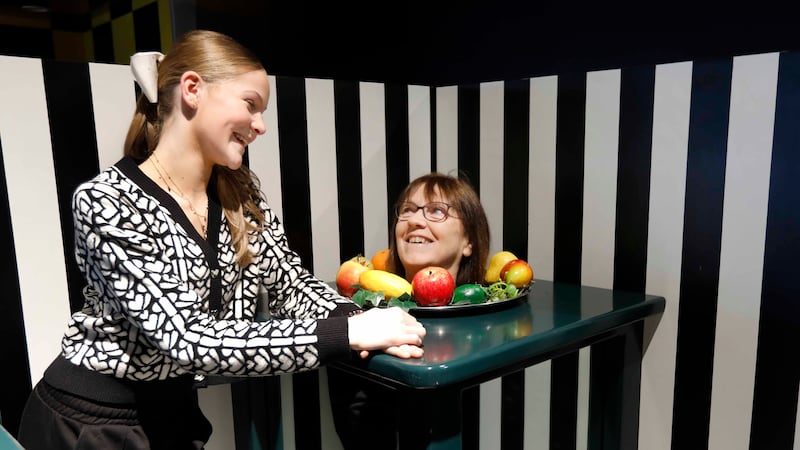An environmentally friendly and inexpensive electrolyte from brown seaweed suitable for use in a battery to generate green electricity has been developed by two students from Carrigtwohill, Co Cork.
The seaweed acts as an electrolyte and is composed of "abundant, thermostable and biodegradable materials", enabling generation of renewable electricity in a capacitor which stores power, explained Sophie O Reilly and Robyn Sloane Lee who attend St Aloysius College.
Their project is one of many at this year’s BTYSTE where young researchers investigated the ability of locally-available natural resources to ensure more sustainable living, while helping to address the climate crisis, enhancing Irish biodiversity or countering Covid-19.
The capacitor cell they built centres around the naturally occurring polymer sodium alginate found in the seaweed which grows abundantly near where they live.
It exhibits good gelling properties, considered essential for an electrolyte, and is inert. When graphite electrodes made of pure carbon are used, there is little threat to the environment or to human health.
They tested various combinations in a variety of electrical circuits. “We experienced much success in our search for green energy,” added Robyn. The use of sodium alginate in combination with three other chemicals performed best, while they are determined to enhance the efficiency even more in coming months.
Wildfires
Transition year students Alex Roche and Eimear Keenan, who attend Moate Community College in Co Westmeath, used native Irish plants to make "a green fire break" prototype.
Horrified by the scale of destruction by wildfires – especially in Killarney, Co Kerry – they concluded "it will suppress the spread of wildfires, while contributing to biodiversity".
Over a number of months, they examined the properties of various native plants taken from gardens, bogs and hedgerows, including their ignitability and water content. A high water and ash content and long combustion time worked best.
While oak proved to be impressive, holly was deceptive as it had a high water content but burned ferociously because of it volatile oils once ignited. None of the suitable plants sustained a flame independently, so they were deployed in their fire break.
What’s more, they supported a wide variety of species include slugs, birds, insects and mammals while also acting as a good food source, they confirmed.
Augmentead reality
Farsaad Ahmad Kamran of Kishoge Community College in Co Dublin was determined to develop "augmented reality glasses" for the visually impaired that were cheap and flexible in improving the quality of life for those who cannot see properly or have dyslexia.
He fulfilled the brief. His prototype uses “artificial intelligence and machine vision” to help interpret the world for the visually impaired. His glasses read out words after a button is pressed and a picture is taken. “It identifies how far and object is away and can estimate what it is, based on what it thinks it is looking at,” he explained. “And it can be used with bluetooth headphones or earbuds.”
He developed a microcomputer with software to perform the task and used 3D printing to enable it to be combined with the glasses. Farsaad, however, believed it could be made less clunky if made in a professional environment. Moreover, he insisted they can be made for less than €100 compared to the less flexible products currently available at between €2,000 and €5,000.
Rowing machine
The huge need for new sources of electricity prompted three students from Ardscoil Rís in Limerick to invent a device to capture potential energy from a rowing machine. But Patrick Stenson, Shane Rafferty and Colm Murphy, members of St Michael's Rowing Club, believed it can be easily applied to treadmills and bicycles.
They built a 12-volt motor, which when combined with battery storage and an electrical inverter can provide power for a variety of household appliances and mobile phones.
Patrick said their clean electrical energy could fit in when the sun is not bright and there is little wind blowing. “I can guarantee there won’t be a day when there are no rowers training,” he added.
Pandemic
A large number of projects examined ways of reducing Covid-19 risk and mental health aspects of the pandemic. A notable achievement on this front was a biodegradable face mask made from seaweed fibres, that prevents acne, skin disease and reduces the spread of respiratory disease. It was manufactured by Hana Haggag, Liam Ferguson and Ava Walsh of St Joseph's Community College in Kilkee, Co Clare.
An abundant supply of brown algae along the coastline around Loop Head made it possible. They baked the seaweed at a temperature of 90 degrees, generating “very crispy powder”, which was then reconstituted in a material used in their face mask.
This year’s projects cover a wide range of topics across health, mental wellbeing, the climate crisis and biodiversity loss – with more than 200 prizes being awarded across four categories. The overall winner who will receive €7,500 in prize money and the chance to represent Ireland at the European Union Contest for Young Scientists will be announced on Friday.
The public can view projects and other BT Young Scientist and Technology Exhibition events through the exhibition's portal. Further details are at btyoungscientist.com
















